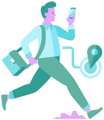Get care now



Peripheral Artery Disease (PAD)
Other arteries in your body, besides your heart, can become blocked with plaque (fatty deposits), too. Peripheral artery disease (PAD) occurs when plaque clogs the arteries in your legs, reducing blood flow to your legs and feet.
The lack of blood flow can cause leg or hip pain. You may notice cramping, pain or tiredness in your leg or hip muscle when you walk or exercise. The feelings go away when you rest but return when you resume activity
PAD usually does not have symptoms until the blockage causes leg pain.
As arteries become blocked, smaller blood vessels carry the blood around the blockage. These vessels are known as collateral blood vessels
If you have PAD, you may feel aches, pains, cramps, numbness or muscle fatigue during exercise. These feelings get better or go away when you stop exercising. When you exercise, your blood flow may not meet your body’s need for extra oxygen.
If you have loss of sensation, coldness and severe pain in your leg, call 911. This means the blood flow to your leg has stopped.

1. In an artery free of plaque (fatty deposits), blood flows freely.

2. When plaque starts choking an artery, blood cannot flow freely, leading to peripheral artery disease (PAD).

3. When an artery becomes blocked, smaller blood vessels around the blockage carry the blood. Those smaller vessels are known as collateral blood vessels.
When the blockages are large enough that the blood flow is nearly or totally blocked, you may feel pain, even during rest. Without a constant supply of oxygen, tissue below the blockage can be permanently damaged.
There are many symptoms of PAD. You may have:
- an aching, cramping, tired feeling or numbness, tingling or pain in your feet, toes, legs or buttocks after walking (The pain goes away after a few minutes.)
- leg pain during the night or during rest that goes away if you hang your leg over the edge of your bed or put your leg up on a footstool
- blue or red discoloration of your foot or leg when sitting or standing
- a wound or sore on your foot that does not heal
- cold feet and cold or numb calves
- dry and scaly feet and legs
- less hair growth on your legs
- no pulse in your foot
- impotence (in men)
